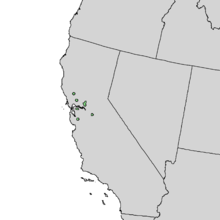Juglans hindsii
Juglans hindsii, commonly called the Northern California walnut and Hinds' black walnut, is a species of walnut tree endemic to Northern California.[2][3] It is commonly called claro walnut by the lumber industry and woodworkers, and is the subject of some confusion over its being the root stock for English walnut orchard stock.
| Juglans hindsii | |
|---|---|
.jpg) | |
| Scientific classification | |
| Kingdom: | Plantae |
| Clade: | Tracheophytes |
| Clade: | Angiosperms |
| Clade: | Eudicots |
| Clade: | Rosids |
| Order: | Fagales |
| Family: | Juglandaceae |
| Genus: | Juglans |
| Section: | Juglans sect. Rhysocaryon |
| Species: | J. hindsii |
| Binomial name | |
| Juglans hindsii | |
 | |
| Natural range of Juglans hindsii | |
Distribution
The historical range of Juglans hindsii is from the San Joaquin Valley and Sacramento Valley to the Inner Northern California Coast Ranges and San Francisco Bay Area, in Northern California.[2]
The tree grows in riparian woodlands, either in mono-species stands, or mixed with California oak species (Quercus spp.) and Fremont cottonwood (Populus fremontii) trees.
- Conservation
Juglans hindsii has only one confirmed native stand remaining. It is listed as Seriously Endangered on the California Native Plant Society Rare Plant Inventory.[4] The IUCN classification is a Vulnerable species. It is threatened by hybridization with orchard trees, urbanization, and habitat conversion to agriculture.
Description
Juglans hindsii is a medium-sized tree of short bulky proportions. It grows up to 30–60 feet (9.1–18.3 m) tall, has a single erect trunk, commonly without branches for 10–40 feet (3.0–12.2 m), and a crown that can be wider than the tree is tall. Trunks commonly reach 5–6 feet (1.5–1.8 m) in diameter near the base of the tree.[5]
The leaf is approximately 1 foot (0.30 m) long, with 13-21 leaflets per leaf, each 2-5" long, with dentate margins. Unlike the Southern California walnut, the vein angles bear tufts of hair.
The nut has a smooth, brown, thick shell, that contains a small edible nutmeat.[6]
Allergenicity
Hind's Walnut (Juglans hindsii) is a severe allergen. Pollination: Occurs in following seasons depending on latitude and elevation: Spring. [7]
Uses
Cultivation
Juglans hindsii has been commercially important as a rootstock for orchard stock of Juglans regia (English walnut) trees all over the world. It is also used as a parent to the fast-growing Luther Burbank hybrid rootstock, commonly called "Paradox" (Juglans hindsii x Juglans regia).[8]
- Ornamental tree
The Northern California walnut is cultivated by specialty California native plant nurseries. It is used as an ornamental tree in traditional and wildlife gardens, and for habitat gardens, natural landscaping projects, and climate compatible drought tolerant gardens. The tree is also planted in habitat restoration projects.
Pests
Juglans hindsii is infested by Rhagoletis juglandis, commonly known as the walnut husk fly, which lays its eggs in the husks of walnut fruit. R. juglandis infests other varieties of walnut trees as well, such as Juglans regia (the English or Persian walnut), Juglans rupestris (a species of walnut indigenous to Arizona and Texas), and Juglans hindsii (the California black walnut).[9]
Lumber
The wood of Juglans hindsii is commonly called claro walnut by the lumber industry and woodworkers.[10] It is highly figured with a rich brown color and striking grain patterns, especially in the crotch areas, where large limbs meet the trunk.[11] It is used in small quantities to make fine furniture and gun stocks, and sold as slabs to make large natural-top tables because of its durability, good working properties, and swirling iridescent figure.
Some confusion exists about the nature of claro walnut because Juglans hindsii is commonly used as the rootstock of orchard trees. The section below the original graft is claro walnut wood, while the section above is the lighter-colored English walnut. Some woodworkers take advantage of this by making the color change a feature of their work.[12]
Taxonomy
The current classification of the plant is as a distinct species.[2] Some botanists and the 1993 edition of "The Jepson Manual" had classified it as Juglans californica subsp. hindsii, a subspecies of Juglans californica (Southern California black walnut).[13][14]
References
- Watson, S. (1998). "Juglans californica". IUCN Red List of Threatened Species. 1998: e.T35154A9915361. doi:10.2305/IUCN.UK.1998.RLTS.T35154A9915361.en.
- Jepson Herbarium (2013): Juglans hindsii
- Calflora: Juglans hindsii . 10.1.2013
- California Native Plant Society Rare Plant Inventory: Juglans californica . accessed 10.1.2013
- "Baker Hardwoods".
- Kershner, Mathews, Nelson, and Spellenberg, National Wildlife Federation field Guide to Trees of North America, 2008, Chanticleer Press, Inc. p. 229
- "Hind's Walnut (Juglans hindsii) Species Details and Allergy Info, Santa clara county, California".
- UC Davis Nut Production: Walnut Rootstock & Scion Selection . Biology and Technology of Fruit & Nut Production . accessed 10.1.2013
- Boyce, A.M. (December 1929). "The Walnut Husk Fly (Rhagoletis juglandis Cresson)". Journal of Economic Entomology. 22: 861–866.
- Taunton.com: Finewood Working — "Claro walnut"
- NW timber.com Archived 2011-01-28 at the Wayback Machine
- Mcfaddenfurniture.com: 'armoire'
- Jepson Manual (1993) Treatment for Juglans californica subsp. hindsii — R. E. Sm.; Hickman, James C., ed. The Jepson Manual: Higher Plants of California. University of California Press. 1993.
- Calflora: "Juglans californica var. hindsii is not an active name in the Calflora species table." . accessed 10.1.2013
- "Some preliminary observations on the California black walnut (Juglans californica)" — Anderson, E. N.; Fremontia: A Journal of the California Native Plant Society. January 2002.
External links


- Jepson Flora Project: Juglans hindsii
- Calflora Database: Juglans hindsii (Northern California black walnut)
- Virginia Tech tree ID: Hind's black walnut (Juglans hindsii)
- Juglans hindsii — U.C. Photo gallery
